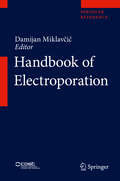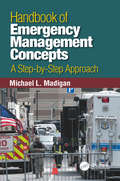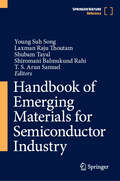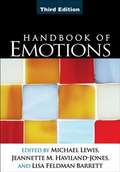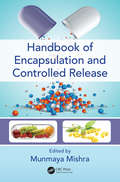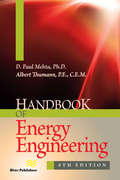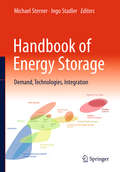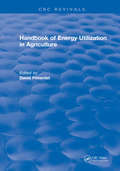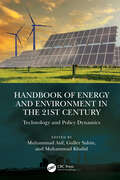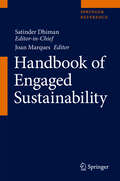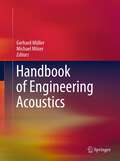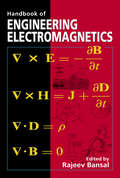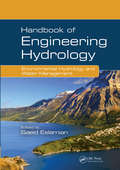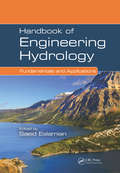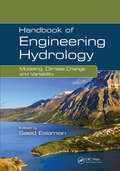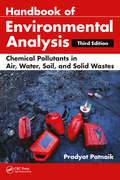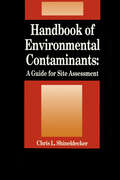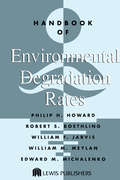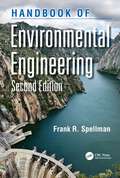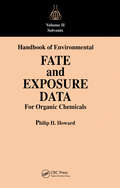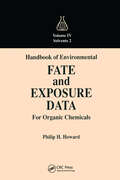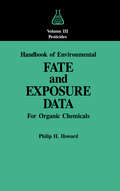- Table View
- List View
Handbook of Electroporation
by Damijan MiklavčičThis major reference work is a one-shot knowledge base on electroporation and the use of pulsed electric fields of high intensity and their use in biology, medicine, biotechnology, and food and environmental technologies. The Handbook offers a widespread and well-structured compilation of 156 chapters ranging from the foundations to applications in industry and hospital. It is edited and written by most prominent researchers in the field. With regular updates and growing in its volume it is suitable for academic readers and researchers regardless of their disciplinary expertise, and will also be accessible to students and serious general readers. The Handbook's 276 authors have established scholarly credentials and come from a wide range of disciplines. This is crucially important in a highly interdisciplinary field of electroporation and the use of pulsed electric fields of high intensity and its applications in different fields from medicine, biology, food processing, agriculture, process engineering, energy and environment. An Editorial Board of distinguished scholars from across the world has selected and reviewed the various chapters to ensure the highest quality of this Handbook.The book was edited by an international team of Section Editors: P. Thomas Vernier, Boris Rubinsky, Juergen Kolb, Damijan Miklavcic, Marie-Pierre Rols, Javier Raso, Richard Heller, Gregor Serša, Dietrich Knorr, and Eugene Vorobiev.
Handbook of Emergency Management Concepts: A Step-by-Step Approach
by Michael L. MadiganThis book provides a step-by-step process that focuses on how to develop, practice, and maintain emergency plans that reflect what must be done before, during, and after a disaster, in order to protect people and property. The communities who preplan and mitigate prior to any incident will be better prepared for emergency scenarios. This book will assist those with the tools to address all phases of emergency management. It covers everything from the social and environmental processes that generate hazards, to vulnerability analysis, hazard mitigation, emergency response, and disaster recovery.
Handbook of Emerging Materials for Semiconductor Industry
by Laxman Raju Thoutam Shiromani Balmukund Rahi Young Suh Song Shubam Tayal T. S. Arun SamuelThe proposed book will be a “one-stop” place for all the young material researchers to understand the recent and reliable material making process, characterization, and reliability test tools. The proposed book is designed to provide basic knowledge to understand and analyse structure-property relationship for reliable emerging material systems for next generation of semiconductor technologies.The book is suggested to engineers and scientists across the world working on various new and novel materials for reliable semiconductor device applications. The book is expected to serve as a reference guide for young scientists and engineers in the field of material science and electronic engineers to acquire latest state-of-art experimental and computational tools to encourage their research activities.Since the scope of the book is generic, the book can be referred by all the students of science and engineering students to create a common awareness about the latest material systems and state-of-art characterization tools that have been broadly utilized to study the physical and chemical properties of different material systems.It introduces the readers to a wide variety of new emerging materials systems including their synthesis, fabrication, measurement, reliability test, modelling and simulations with in-depth analysis of selective applications.This book contains the state-of-art research updates in the various fields of semiconductor, artificial intelligence (AI), bio-sensor, biotechnology, with respect to reliable material research. Therefore, various students who are eager to get a job in semiconductor/AI/Autonomous car/biotechnology are strongly recommended to read this book and learn about related state-of-art knowledge.
Handbook of Emotions, Third Edition
by Michael Lewis Jeannette Haviland-JonesWidely regarded as the standard reference in the field, this handbook comprehensively examines all aspects of emotion and its role in human behavior. The editors and contributors are foremost authorities who describe major theories, findings, methods, and applications. The volume addresses the interface of emotional processes with biology, child development, social behavior, personality, cognition, and physical and mental health. Also presented are state-of-the-science perspectives on fear, anger, shame, disgust, positive emotions, sadness, and other distinct emotions. Illustrations include seven color plates.
Handbook of Encapsulation and Controlled Release (Encapsulation and Controlled Release)
by Munmaya MishraThe field of encapsulation, especially microencapsulation, is a rapidly growing area of research and product development. The Handbook of Encapsulation and Controlled Release covers the entire field, presenting the fundamental processes involved and exploring how to use those processes for different applications in industry. Written at a level comp
Handbook of Energy Engineering (Energy Engineering and Systems)
by Albert Thumann D. Paul MehtaWith new chapters on electrical system optimization and ISO 50001, this edition also covers the latest updates to codes and standards in the energy industry. Also included are chapters on energy economic analysis, energy auditing, waste heat recovery, utility system optimization, HVAC, cogeneration, control systems, energy management, compressed air system optimization and financing energy projects. Additional topics include emerging technologies such as oxy-fuel combustion, high efficiency burners, enhanced heat exchangers, and ceramic membranes for heat recovery as well as information on how to do an energy analysis of any system; electrical system optimization; state-of-the-art lighting and lighting controls. This reference will guide you step by step in applying the principles of energy engineering and management to the design of electrical, HVAC, utility, process and building systems for both new design and retrofit projects. The text is thoroughly illustrated with tables, graphs, diagrams and sample problems.
Handbook of Energy Management in Agriculture
by Amitava Rakshit Vijay Singh Meena Rahul Datta Asim Biswas Deepranjan SarkarThis handbook provides a holistic overview of different aspects of energy management in agriculture with an orientation to address the sustainable development goals. It covers possible applications not only from a technical point of view, but also from economic, financial, social, regulatory, and political viewpoints. Agriculture is one of the most imperative sectors that contribute to the economy across different agro-ecologies of the universe with energy inputs in each stage of production, from making and applying chemicals to fueling tractors that lay seeds and harvest crops to electricity for animal housing facilities. The majority of agricultural research has focused on the use of input, production, and productivity, whereas rational energy budgeting and use remain an overlooked and likely underestimated segment, ignored so far while formulating agro-ecosystem framework. Energy management study is a new frontier of agriculture and is challenging duе to complex enterprises, spatial-temporal variability, exposure to pollution, and the predominant effect of the anthropogenic factor on ecology and environment. But it is worth taking the challenge considering the important prerequisite role of energy for sustainable development which has been evidenced from increasing research in recent times. Of recent origin, there are critical, in-depth studies around the globe assessing the capture and flow of energy in the ecosystem, which will help to develop a conceptual framework to incorporate this vital resource in the agriculture management template. This book is a state-of-the-art resource for a broad group of readers including a diversity of stakeholders and professionals in universities, public energy institutions, farmers and farming industry, public health and other relevant institutions, and the broader public as well.
Handbook of Energy Storage: Demand, Technologies, Integration
by Michael Sterner Ingo StadlerThe authors of this Handbook offer a comprehensive overview of the various aspects of energy storage. After explaining the importance and role of energy storage, they discuss the need for energy storage solutions with regard to providing electrical power, heat and fuel in light of the Energy Transition. The book’s main section presents various storage technologies in detail and weighs their respective advantages and disadvantages. Sections on sample practical applications and the integration of storage solutions across all energy sectors round out the book. A wealth of graphics and examples illustrate the broad field of energy storage, and are also available online. The book is based on the 2nd edition of the very successful German book Energiespeicher. It features a new chapter on legal considerations, new studies on storage needs, addresses Power-to-X for the chemical industry, new Liquid Organic Hydrogen Carriers (LOHC) and potential-energy storage, and highlights the latest cost trends and battery applications. “Finally – a comprehensive book on the Energy Transition that is written in a style accessible to and inspiring for non-experts.” Franz Alt, journalist and book author “I can recommend this outstanding book to anyone who is truly interested in the future of our country. It strikingly shows: it won’t be easy, but we can do it.” Prof. Dr. Harald Lesch, physicist and television host
Handbook of Energy Systems in Green Buildings
by Ruzhu Wang Xiaoqiang ZhaiThis handbook provides a comprehensive summary on the energy systems used in green buildings, with a particular focus on solar energy - the most common renewable energy source applied in this field. With the growing concern about environmental protections, the concepts of green building have been widely promoted and implemented in nowadays building designs and constructions. Among all, sustainable energy systems, including energy harvesting, conversion, and storage, is one of most important design factors in green buildings. Unlike traditional energy systems which highly rely on fossil fuel, green buildings utilize renewable energy source or high efficient energy systems, or both, to provide environmental friendly, low carbon waste energy. The most updated concepts, designs, technologies developed and implemented in heat pumps, cooling systems, power systems, and energy storage will be discussed here in details.This handbook is subdivided into 7-9 main sections to provide an in-depth discussion from foundational principles to practical techniques. In addition, different cases about green energy systems implemented in global will be discussed. The book will be structured easy-to-read, to make it more accessible to graduate students and professionals in diverse scientific and engineering communities, including applied physics, civil engineering, electrical engineering, mechanical engineering, material engineering, and chemical engineering.
Handbook of Energy Utilization In Agriculture
by David PimentelThe aim of this volume is to collect and present available data, both published and unpublished, on energy use in agriculture and forestry production. Energy analyses for some sciences such as ecology are not new, but their applications to agriculture started in 1973. These analyses have grown rapidly in number and complexity. This handbook is intended for agriculturalists and others concerned with energy use in crop, livestock, and forestry production.
Handbook of Energy and Environment in the 21st Century: Technology and Policy Dynamics
by Muhammad Asif Guller Sahin Muhammad KhalidThe Handbook of Energy and Environment in the 21st Century discusses the key dimensions of the present energy scenario as well as the emerging trends. Global responses to environmental challenges are examined, taking into account technical, economic, social, and policy perspectives. Responding to the latest developments, the book also discusses the impacts of natural disasters and pandemics on energy in the context of energy and environmental implications. Further, it presents various related topics such as the dynamics of sustainable energy transition, renewable energy implementation, decarbonization of fossil fuels, electric mobility, distributed generation systems, and energy security. The book will benefit a wide range of stakeholders from the fields of energy, environment, socioeconomics, geopolitics, and sustainable development. It serves as a valuable reference for academics, researchers, and analysts in these fields. Provides a comprehensive and balanced account of the interwoven subjects of energy and environment in terms of technology and policy dynamics. Incorporates up-to-date data, case studies, and comparative assessments.
Handbook of Engaged Sustainability
by Satinder Dhiman Joan MarquesThis handbook is based on the premise that in order for sustainability to be sustainable, a profound psychological transformation has to take place at the individual and collective level. Focusing on the practice of environmental sustainability, this handbook will explore the application of sustainability in a wide variety of contemporary contexts—from economics of consumption and growth to government policy, sustainable cities, and sustainable planet. The editors believe that the way to achieve sustainable, harmonious living in all spheres is through lived or engaged sustainability at the personal, team, and organizational levels. It is impossible to separate economic development issues from environment issues. In its most practical aspect, sustainability is about understanding the interconnections among environment, society, and economy. This book aims to provide a comprehensive overview of current theories and approaches in the area of engaged sustainability for academics, researchers and practitioners. Specifically, it will focus on making responsible decisions that will reduce humanity’s negative impact on the environment. While various social and political initiatives for sustainability are welcome, one cannot really enact sustainability into legislative laws. Something has to change fundamentally at the level of a common person in the street. The Handbook of Engaged Sustainability acknowledges the classic literature, theories and principles in the area of sustainability, but also provides new theories and approaches from global scholars and practitioners in the field. It will also provide a well-structured pedagogical framework with real life case examples. The aim of this handbook is to expand the reader’s thinking to one of “big-picture awareness” and a “cosmic vision” of sustainability, a vision that extends from our neighborhoods to our communities, to states, countries, globe, galaxy, and envelops the entire Universe! This book will serve as an essential resource for researchers, scholars and students of sustainability, ethics, corporate social responsibility and environmental economics, as well as consultants, business and team leaders, and anyone interested in engaged sustainability.
Handbook of Engineering Acoustics
by Michael Möser Gerhard MüllerThis acoustics handbook for mechanical and architectural applications is a translation of the German standard work on the subject. It not only describes the state of art of engineering acoustics but also gives practical help to engineers for solving acoustic problems. It deals with the origin, the transmission and the methods of abatement of air-borne and structure-borne sound of different kinds, from traffic to machinery and flow induced sound.
Handbook of Engineering Electromagnetics
by Rajeev BansalEngineers do not have the time to wade through rigorously theoretical books when trying to solve a problem. Beginners lack the expertise required to understand highly specialized treatments of individual topics. This is especially problematic for a field as broad as electromagnetics, which propagates into many diverse engineering fields. The time h
Handbook of Engineering Hydrology: Environmental Hydrology and Water Management
by Saeid EslamianWhile most books examine only the classical aspects of hydrology, this three-volume set covers multiple aspects of hydrology, and includes contributions from experts from more than 30 countries. It examines new approaches, addresses growing concerns about hydrological and ecological connectivity, new quantitative and qualitative managing techniques
Handbook of Engineering Hydrology: Fundamentals and Applications
by Saeid EslamianWhile most books only examine the classical aspects of hydrology, the three-volume set covers multiple aspects of hydrology, and includes contributions from experts from more than 30 countries. It examines new approaches, addresses growing concerns about hydrological and ecological connectivity, and considers the worldwide impact of climate change.
Handbook of Engineering Hydrology: Modeling, Climate Change, and Variability
by Saeid EslamianWhile most books examine only the classical aspects of hydrology, this three-volume set covers multiple aspects of hydrology. It examines new approaches, addresses growing concerns about hydrological and ecological connectivity, and considers the worldwide impact of climate change.It also provides updated material on hydrological science and engine
Handbook of Environmental Analysis: Chemical Pollutants in Air, Water, Soil, and Solid Wastes, Third Edition
by Pradyot PatnaikThe Handbook will cover all aspects of environmental analysis and will examine the emergence of many new classes of pollutants in recent years. It will provide information on an array of topics from instrumentation, analytical techniques, and sample preparations to statistical calculations, chemical structures, and equations. It will present the tools and techniques required to measure a wide range of toxic pollutants in our environment. It will be fully revised throughout, and will add four new chapters (Microbial Analysis, Chlorophyll, Chlorine, Chloramines and Chlorine Dioxide, and Derivatization Reactions in Environmental Analysis).
Handbook of Environmental Contaminants: A Guide for Site Assessment
by Chris ShineldeckerHandbook of Environmental Contaminants: A Guide for Site Assessment is an indispensable working reference for environmental assessment professionals faced with determining potential environmental contaminants that might be found in the soil, groundwater, or air of a property or facility. The book provides a comprehensive listing of potential contaminants associated with hundreds of industries, activities, and processes. The types of properties covered range from agricultural to heavy industrial. The products and processes covered range from the processing of yeast to the constituents of rocket fuel. The book also discusses products associated with the degradation of common chemical solvents in the environment.Handbook of Environmental Contaminants: A Guide for Site Assessment is an important reference for environmental consultants, workers on Superfund sites, public health and safety professionals, attorneys, educators and students, and lenders.
Handbook of Environmental Degradation Rates
by PHILIP H. HOWARD, ROBERT S. BOETHLING, WILLIAM F. JARVIS, WILLIAM M. MEYLAN AND EDWARD M. MICHALENKOIn order to assess the environmental exposure from chemicals in various media, you must know the rate at which a chemical will degrade. Handbook of Environmental Degradation Rates saves you the time and money collecting and evaluating this important information. The Handbook provides rate constant and half-life ranges for various processes and combines them into ranges for different media (air, groundwater, surface water, soils), which can be directly entered into various models.Some of the processes the Handbook includes are aerobic and anaerobic biodegradation, direct photolysis, hydrolysis, and reaction with various oxidants or free radicals (e.g., hydroxyl radical and ozone in the atmosphere). Experimental data are used and cited when available, and validated estimation methods are used when no experimental data are available. Researched and organized by leading experts, Handbook of Environmental Degradation Rates is easy-to-use and is well indexed by chemical name and CAS Number.
Handbook of Environmental Engineering (Applied Ecology And Environmental Management Ser. #9)
by Frank R. SpellmanThis new edition provides a practical view of pollution and its impact on the natural environment. Driven by the hope of a sustainable future, it stresses the importance of environmental law and resource sustainability and offers a wealth of information based on real-world observations and expert experience. It presents a basic overview of environmental pollution, emphasizes key terms, and addresses specific concepts in advanced algebra, fundamental engineering, and statistics. In addition, it considers socioeconomic, political, and cultural influences and provides an understanding of how to effectively treat and prevent air pollution, implement industrial hygiene principles, and manage solid waste, water, and wastewater operations. The Handbook of Environmental Engineering is written in a down-to-earth style for a wide audience, as it appeals to technical readers, consultants, policymakers, as well as a wide range of general readers. Features: Updated throughout, with a new chapter on modern trends in environmental engineering, the book further emphasizes climate change effects on water/wastewater infrastructure Examines the physical, chemical, and biological processes fundamental to understanding the environment fate and engineered treatment of environmental contaminants Presents technologies to prevent pollution at the source as well as treatment and disposal methods for remediation Identifies multiple environmental pollutants and explains the effects of each Includes the latest environmental regulatory requirements.
Handbook of Environmental Fate and Exposure Data For Organic Chemicals, Volume II
by Philip H. HowardThis 5-volume set allows you to assess the health and environmental effects of chemicals by determining the routes of exposure of the chemical to sensitive organisms. Environmental Fate and Exposure of Organic Chemicals provides relevant facts on how individual chemicals behave in the environment and how humans and environmental organisms are exposed to the chemicals during their production, rise, transport, and disposal.Each chemical is prepared by one of the best-known organizations in environmental fate and exposure and is peer-reviewed by a panel of expert scientists. The information on each chemical includes all experimental values and references for physical properties, all chemical fate studies, and all available monitoring data and interpretative summaries.
Handbook of Environmental Fate and Exposure Data For Organic Chemicals, Volume V
by Philip H. HowardIn order to assess the health and environmental effects of a chemical, you need to determine the exposure of the chemical to sensitive organisms as well as to assess the likely effects. The chemicals in Volume V of the Handbook of Environmental Fate and Exposure Data for Organic Chemicals set are mostly solvents and cover many of the natural products and hydrochlorofluorocarbons and hydrofluorocarbons being considered as replacements for harmful chlorinated solvents and chlorofluorocarbons. The chemicals are listed in alphabetical order by their most easily recognized names. A cumulative index allows you to look up each chemical by chemical name synonym, Chemical Abstracts Service (CAS) number, and chemical formula. Like all of the volumes in the series, this new volume details how individual chemicals are released, transported, and degraded in the environment, as well as how they are exposed to humans and environmental organisms. FeaturesProvides useful information for hazardous waste cleanup Helps you to make exposure assessments Provides workplace exposure and ambient monitoring data as well as detection in foods Includes information on environmental persistence and transport Includes highly reliable data prepared by a well-known firm in environmental fate
Handbook of Environmental Fate and Exposure Data for Organic Chemicals, Volume IV
by Philip H. HowardThis 5-volume set allows you to assess the health and environmental effects of chemicals by determining the routes of exposure of the chemical to sensitive organisms. Environmental Fate and Exposure of Organic Chemicals provides relevant facts on how individual chemicals behave in the environment and how humans and environmental organisms are exposed to the chemicals during their production, rise, transport, and disposal.Each chemical is prepared by one of the best-known organizations in environmental fate and exposure and is peer-reviewed by a panel of expert scientists. The information on each chemical includes all experimental values and references for physical properties, all chemical fate studies, and all available monitoring data and interpretative summaries.
Handbook of Environmental Fate and Exposure Data: For Organic Chemicals, Volume III Pesticides
by PhilipH. HowardThis 5-volume set allows you to assess the health and environmental effects of chemicals by determining the routes of exposure of the chemical to sensitive organisms. Environmental Fate and Exposure of Organic Chemicals provides relevant facts on how individual chemicals behave in the environment and how humans and environmental organisms are exposed to the chemicals during their production, rise, transport, and disposal.Each chemical is prepared by one of the best-known organizations in environmental fate and exposure and is peer-reviewed by a panel of expert scientists. The information on each chemical includes all experimental values and references for physical properties, all chemical fate studies, and all available monitoring data and interpretative summaries.
